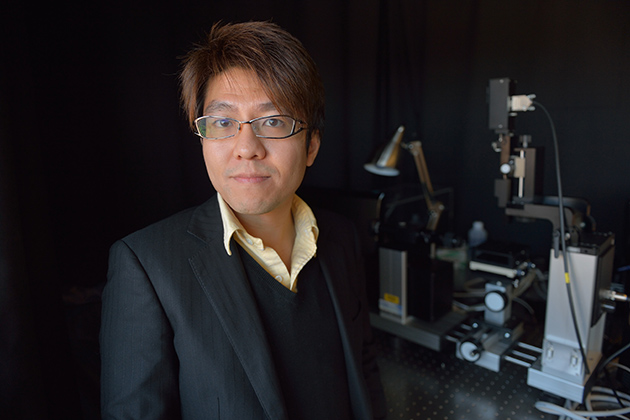
Anson Ma, an assistant professor of chemical engineering with a dual appointment in the Institute of Materials Science Polymer Program, has received a National Science Foundation Early Concept Grant for Exploratory Research (EAGER) award. The two-year grant supports his research aimed at understanding how nanoparticles flow in the bloodstream, with the goal of determining whether nanoparticles can be employed to improve the delivery of cancer-fighting drugs to tumors while reducing the toxic side effects to normal tissues.
Ma, who earned his Ph.D. from the University of Cambridge in the UK, joined UConn in August 2011 following a two-year appointment as the J. Evans Attwell-Welch Postdoctoral Fellow at Rice University. He believes nanoparticles offer significant promise as a vehicle for delivering chemotherapy drugs more directly to the site of the diseased tissues than conventional methods. The focus of his EAGER award will be to test the use of nanoparticles for drug delivery, and to understand, from the time of the injection of nanoparticles into the bloodstream, how these nanoparticles can really get into the tumor.
He explains that tumors display certain characteristics that he and his research team intend to exploit: they typically produce complex networks of blood vessels that enable the cancerous cells to proliferate, but develop poor lymphatic – or drainage – systems. Researchers call this combination of characteristics ‘enhanced permeability and retention,’ or EPR, and it allows doctors to treat the cancer using drugs that accumulate in the tissue of the tumor to a greater degree than in healthy cell tissues.
Applying engineering skills to the study of the human body
In seeking to unveil the processes at work in delivering drug-carrying nanoparticles to a tumor, the research team will first build novel microfluidic devices that simulate the bloodstream. They will then study the flow dynamics of nanoparticles within these simulated blood flows, with the aim of better understanding the EPR effect. Another facet of the research centers on the roles of particle shape and size, and blood constituents in delivering drugs to the tumor site.
“In nanomedicine, nanoparticles are used for drug delivery,” Ma says. “Basically, we take a nanoparticle and decorate it with ligands that will recognize the tumor interface. For intravenous, or IV, cancer drug delivery, doctors prepare a solution in which the nanoparticles are well suspended. Once the IV drugs enter the bloodstream, it’s important for the nanoparticles to remain well suspended in the blood in order to reach the tumor. But blood is a very complicated fluid, and we don’t precisely know how the particles travel. For example, they may aggregate together or do other things, like release prematurely.”
Scientists have observed the tendency of white blood cells to accumulate next to the walls of blood vessels, while red blood cells tend to flow through the center. Ma says researchers don’t really understand why this happens and some theorize that, because the red blood cells cannot escape through the vessel walls, they concentrate in the middle, forcing the white blood cells toward the walls. This process is called “margination,” and one of Ma’s aims is to apply engineering principles to tease out the mechanism.
“We put on our engineer hats and try to understand the process. The implication is, if the same thing can happen with nanoparticles, that is, with white blood cells accumulating near the blood vessel walls, it may be easier for the drug-carrying nanoparticles to enter the tumor.”
Challenges of nanoscale research
The extremely small size of nanoparticles poses a challenge to scientists hoping to see how they behave. To compensate, the team will tag the nanoparticles with fluorescent dye that will allow the researchers to track them using optical microscopy to observe the fluid dynamic behavior of the simulated blood. The team will also carefully examine whether the process of tagging the nanoparticle will, itself, alter the particle’s dynamic flow behavior.
Another challenge involves the optimal size of the nanoparticles. Ma says the leaky, or more porous, nature of tumor walls suggests it may be easier for nanoparticles to slip inside the tumor site. And, once there, the nanoparticles are more likely to stay trapped within the tumor walls because of the characteristic poor lymphatic system. The larger the nanoparticles, the more likely it is that they can’t escape.
“The literature suggests that for drug delivery, the particles should be on the order of 100 nanometers,” he says. “If they are too small, the body will simply remove them too quickly. You want them to be big enough, but also small enough to be carried through the blood vessels and through the tumor walls.”
For the EAGER project, Ma and his team will inject dye-tagged nanoparticles into the microfluidic bloodstream simulator and study how the blood and nanoparticles flow dynamically. They will also see how certain factors like particle shape and surface chemistry influence the hydrodynamics of the nanoparticles. From these observations, they hope to understand the EPR and margination effects, tailor the design of drug-delivering nanoparticles, and ultimately help the pharmaceutical community develop better cancer-fighting drugs with few negative side effects on patients.
“Our bodies are intriguingly complex, but this project will be the first step in understanding the problem from an engineering perspective.” Ma says.
Ma leads a project team comprising one graduate student (Erik Carboni) and three undergraduate students (Vinit Patel, Meaghan Sullivan, and Diva Evans) from the Chemical Engineering Program. The team is also collaborating with professors Leslie Shor from Chemical Engineering, Xiuling Lu from Pharmaceutical Sciences, and Suzy Torti from the UConn Health Center.


